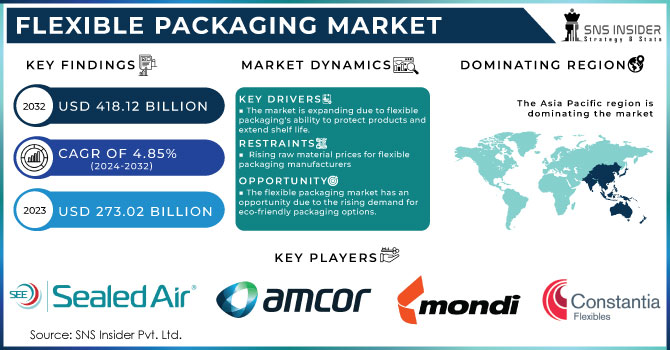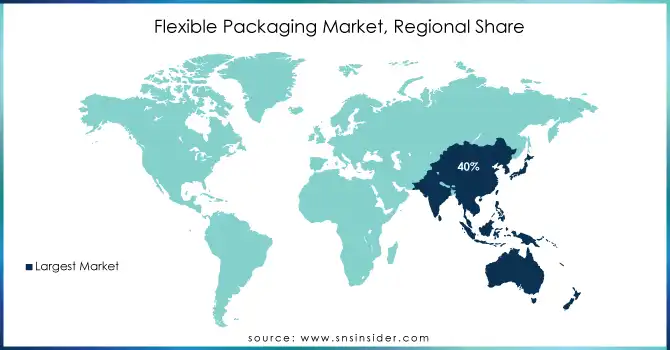Flexible Packaging Market Size:

Get More Information on Flexible Packaging Market - Request Sample Report
The Flexible Packaging Market size was valued at USD 257.14 billion in 2023 and is expected to Reach USD 411.78 billion by 2032 and grow at a CAGR of 5.37% over the forecast period of 2024-2032.
The flexible packaging market is experiencing significant growth, driven by its adaptability, cost-effectiveness, and alignment with consumer preferences for convenience and sustainability. Industries such as food and beverage, pharmaceuticals, and personal care are increasingly adopting flexible packaging solutions due to their lightweight nature and ability to extend product shelf life. For instance, in India, the flexible packaging sector is expanding rapidly, with a notable preference for flexible plastic packaging, which accounts for approximately 75% of the country's plastic packaging market. This trend is largely attributed to the fast-moving consumer goods (FMCG) sector's demand for versatile and economical packaging options.
Technological advancements have enhanced the functionality of flexible packaging, leading to innovations such as high-barrier materials that protect contents from moisture and oxygen, thereby preserving product quality. The rise of e-commerce has further propelled the demand for flexible packaging, as it offers durability and reduced shipping costs, making it an ideal choice for online retailers. Sustainability is a key trend shaping the market, with consumers and regulators pushing for eco-friendly packaging solutions. This has led to increased interest in bioplastics and recyclable materials. However, challenges such as the need for industrial composting facilities and the presence of chemical additives in some bioplastics have been identified, indicating that while bioplastics offer potential environmental benefits, their green credentials require careful scrutiny.
The industry is also witnessing consolidation, as evidenced by significant mergers and acquisitions. For example, Amcor's USD 8.4 billion acquisition of Berry Global Group has solidified its position as the largest plastic packaging company globally, highlighting the trend toward consolidation to achieve economies of scale and enhanced market presence.
MARKET DYNAMICS
DRIVERS
-
The flexible packaging market is growing rapidly, driven by demand for convenience, sustainability, e-commerce expansion, and technological advancements, despite recycling challenges and raw material price fluctuations.
The flexible packaging market is experiencing significant growth, driven by the rising demand for convenience packaging across various industries. Consumers prefer lightweight, portable, and resealable packaging, especially in the food & beverage and pharmaceutical sectors, due to its ease of use and extended product shelf life. The increasing urban population, changing lifestyles, and the booming e-commerce sector further contribute to market expansion. Sustainability is also a key trend, with manufacturers shifting toward recyclable and biodegradable materials to meet regulatory and consumer demands. Technological advancements, such as high-barrier films and digital printing, are enhancing packaging efficiency and aesthetics. However, challenges like recycling difficulties and fluctuating raw material costs pose constraints. Despite this, the market continues to grow, with Asia-Pacific leading due to rapid industrialization and changing consumption patterns. The future of flexible packaging lies in smart packaging innovations and increased adoption of sustainable alternatives.
RESTRAINT
-
The multi-layered structure of flexible packaging enhances durability but complicates recycling, leading to environmental concerns, regulatory pressure, and the push for sustainable alternatives despite cost and infrastructure challenges.
Flexible packaging often consists of multi-layered materials, including plastic films, aluminum, and adhesives, designed to enhance durability and barrier properties. However, this complex composition makes recycling challenging, as separating these layers requires advanced processing technology that is not widely available. As a result, a significant portion of flexible packaging ends up in landfills, contributing to environmental pollution. Governments and regulatory bodies worldwide are imposing strict regulations to promote sustainable packaging solutions, pushing manufacturers to develop recyclable or biodegradable alternatives. The rising consumer awareness regarding plastic waste is also pressuring companies to adopt eco-friendly packaging options. However, transitioning to sustainable materials can be costly and technologically demanding, posing a challenge for manufacturers, especially in price-sensitive markets. To address these concerns, companies are investing in research and development to create mono-material flexible packaging and improve recyclability, but widespread adoption remains a work in progress due to infrastructure and cost limitations.
MARKET SEGMENTATION
By Material
The Plastics segment dominated with the market share over 68% in 2023, due to its numerous advantages. Plastics are versatile, lightweight, and cost-effective, making them ideal for a wide range of packaging applications. Additionally, they offer excellent barrier properties, protecting contents from moisture, light, and air, thus extending shelf life. Materials like polyethylene (PE) and polypropylene (PP) are commonly used for flexible packaging because of their durability and adaptability across diverse industries such as food, beverages, and consumer goods. As a result, plastics continue to lead the flexible packaging market in terms of both share and demand.
By Application
The Food segment dominated with the market share over 38% in 2023, due to its significant demand for convenience, longer shelf life, and sustainability. Flexible packaging offers easy-to-use solutions such as pouches, bags, and wraps, which appeal to consumers looking for portability and convenience in food products. The rising need for extended shelf life to reduce food waste has also driven the adoption of flexible materials, which provide excellent barrier properties against moisture, oxygen, and light. Additionally, with growing environmental concerns, consumers and manufacturers are shifting toward sustainable packaging options, such as recyclable and biodegradable flexible materials.
KEY REGIONAL ANALYSIS
The Asia-Pacific region dominated with the market share over 44% in 2023. This dominance is driven by several factors, including the rapid industrialization, urbanization, and economic growth across countries like China, India, Japan, and Southeast Asia. These nations are major manufacturing hubs, particularly for consumer goods, food and beverages, and pharmaceuticals, which rely heavily on flexible packaging for its cost-effectiveness, lightweight, and durability. The region also benefits from a growing middle class and an increase in disposable income, which fuels the demand for packaged products. Furthermore, innovations in packaging technology and material development, alongside rising environmental awareness, have spurred growth in sustainable packaging solutions.
Europe is experiencing rapid growth in the Flexible Packaging Market due to a combination of factors. One of the main drivers is the increasing demand for sustainable and eco-friendly packaging solutions, as businesses and consumers alike are becoming more environmentally conscious. Regulations around plastic waste and recycling are prompting manufacturers to innovate with recyclable, biodegradable, and compostable materials. Additionally, technological advancements are enabling the production of more efficient, cost-effective, and high-quality flexible packaging. These innovations are contributing to greater adoption across various industries. Expanding end-use sectors, such as food and beverages, personal care, and pharmaceuticals, also play a significant role.

Get Customized Report as per your Business Requirement - Request For Customized Report
Some of the major key players of the Flexible Packaging Market
-
Sealed Air Corporation (Cryovac food packaging, Bubble Wrap cushioning)
-
Amcor Ltd (AmPrima recycle-ready packaging, LiquiForm bottles)
-
Constantia Flexibles International GmbH (EcoLam monomaterial packaging, die-cut lids)
-
Mondi plc (PerFORMing paper-based trays, FlexziBox stand-up pouches)
-
Sonoco Products Company (FlexSHIELD coated paper, EnviroFlex pouches)
-
Wipak Group (GreenChoice sustainable films, Steriking medical packaging)
-
Ukrplastic (Laminated flexible films, barrier shrink bags)
-
Huhtamaki Oyj (Flexible food packaging, Push Tab® blister lids)
-
Bemis Company Inc (SmartTack resealable films, ClearShield high-barrier films)
-
Ampac Holding (No.2 Pouch recyclable packaging, Retort pouches)
-
Berry Global Group, Inc. (Entour sustainable films, flexible food wrap)
-
Coveris Holdings S.A. (Form-Fill-Seal films, recyclable barrier films)
-
Uflex Ltd (FlexiTubes, FlexFresh breathable films)
-
ProAmpac (ProActive recyclable pouches, QuadFlex bags)
-
Clondalkin Group (Printed lidding films, waxed paper wraps)
-
Transcontinental Inc. (TC Transcontinental) (recyclable multilayer films, compostable packaging)
-
Smurfit Kappa (Bag-in-Box solutions, paper-based flexible packaging)
-
Klöckner Pentaplast (kp) (Flexible films, rollstock, laminates, shrink films)
-
INEOS (Flexible polyethylene (PE) films, polypropylene (PP) films, multilayer barrier films)
-
American Packaging Corporation (APC) (Flexible packaging films, printed films, pouches, laminates)
Suppliers for (cutting-edge packaging designs that enhance product protection, shelf life) on Flexible Packaging Market
-
Amcor Plc
-
Berry Global Group Inc
-
Mondi Group
-
Sealed Air Corporation
-
Huhtamaki PPL
-
UFlex Limited
-
Tetra Pak International SA
-
Winpak Ltd
-
Essel Propack
-
Cosmo Films
RECENT DEVELOPMENT
In May 2024: Amcor and AVON jointly introduced the AmPrima Plus refill pouch for AVON Little Black Dress classic shower gels in China. This recycle-ready packaging is expected to reduce the carbon footprint by 83%, and decrease water consumption and renewable energy usage by 88% and 79%, respectively, when recycled.
In April 2024: Klöckner Pentaplast (kp), a key player in the food packaging industry, announced the launch of its first food packaging trays made entirely from 100% recycled PET (rPET) derived from trays. This innovative kp tray marks the first-ever use of fully recycled tray material, and is the result of KP’s Tray2Tray initiative, which aims to redefine PET recycling standards. The president of food packaging at KP highlighted this milestone as a significant breakthrough in the packaging sector.
In March 2024: INEOS unveiled a new premium snack packaging made from 50% recycled plastics. This packaging is produced by converting plastic waste into food-grade material through an advanced recycling process, which complements traditional mechanical recycling. This innovative method ensures the recycled material meets stringent EU regulatory requirements for food contact and medical device applications.
In February 2024: American Packaging Corporation (APC), a leader in flexible packaging solutions, launched a new RE Design for Recycle flexible packaging technology aimed at frozen food products such as fruits and vegetables. This new technology expands APC’s sustainable packaging portfolio, which includes solutions for compostability, circular and renewable content, and various recycling options. The flexible packaging structure adheres to the Association of Plastic Recyclers' (APR) guidelines.
| Report Attributes | Details |
|---|---|
| Market Size in 2023 | USD 257.14 billion |
| Market Size by 2032 | USD 411.78 billion |
| CAGR | CAGR of 5.37% From 2024 to 2032 |
| Base Year | 2023 |
| Forecast Period | 2024-2032 |
| Historical Data | 2020-2022 |
| Report Scope & Coverage | Market Size, Segments Analysis, Competitive Landscape, Regional Analysis, DROC & SWOT Analysis, Forecast Outlook |
| Key Segments | • By Material (Plastics [Polyethylene (PE), Polypropylene (PP), Polyamide (PA), Polyvinyl Chloride (PVC), Polystyrene (PS), Others], Paper, Metal, Bioplastics) • By Product (Bags, Pouches [Retort Pouches, Refill Pouches], Rollstock, Films & Wraps, Others) • By Application (Food, Beverages, Pharmaceutical & Healthcare, Personal Care & Cosmetics, Others) |
| Regional Analysis/Coverage | North America (US, Canada, Mexico), Europe (Eastern Europe [Poland, Romania, Hungary, Turkey, Rest of Eastern Europe] Western Europe] Germany, France, UK, Italy, Spain, Netherlands, Switzerland, Austria, Rest of Western Europe]), Asia Pacific (China, India, Japan, South Korea, Vietnam, Singapore, Australia, Rest of Asia Pacific), Middle East & Africa (Middle East [UAE, Egypt, Saudi Arabia, Qatar, Rest of Middle East], Africa [Nigeria, South Africa, Rest of Africa], Latin America (Brazil, Argentina, Colombia, Rest of Latin America) |
| Company Profiles | Sealed Air Corporation, Amcor Ltd, Constantia Flexibles International GmbH, Mondi plc, Sonoco Products Company, Wipak Group, Ukrplastic, Huhtamaki Oyj, Bemis Company Inc, Ampac Holding, Berry Global Group, Inc., Coveris Holdings S.A., Uflex Ltd, ProAmpac, Clondalkin Group, Transcontinental Inc., Smurfit Kappa, Klöckner Pentaplast, INEOS, American Packaging Corporation. |
| Key Drivers | • The flexible packaging market is growing rapidly, driven by demand for convenience, sustainability, e-commerce expansion, and technological advancements, despite recycling challenges and raw material price fluctuations. |
| Restraints | • The multi-layered structure of flexible packaging enhances durability but complicates recycling, leading to environmental concerns, regulatory pressure, and the push for sustainable alternatives despite cost and infrastructure challenges. |

